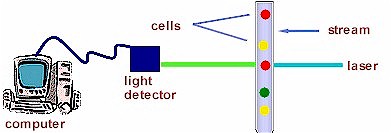|
|
|
About Flow Cytometry
Flow Cytometry is the measurement of physical and chemical characteristics of small
particles using a flow cytometer. Flow cytometry has many applications in the areas of research,
health care, and commerce.
How a Flow Cytometer Works
Biological particles of interest, such as tumor cells, are placed in a liquid suspension. A
fluorescent dye, selected because it will bind to the particles of interest, is added to the
solution. The suspension is made to flow in a stream past a light source, usually a laser
beam, one particle at a time. The wavelength of the light is selected such that it causes
the dye, which is attached to the desired particles, to fluoresce. A computer counts and/or
analyzes the cells or other particles as they pass through the laser beam and fluoresce.

Cells or other particles can also be sorted from the stream and diverted into separate
containers by applying a charge to the particles of interest. Some particle characteristics, such as size and
shape, do not require the use of dyes. These characteristics are determined by the light
dispersion they cause as the particles flow past the laser beam.
Top of Page
|

